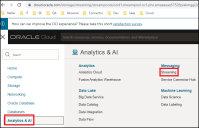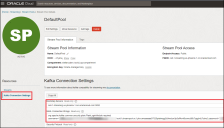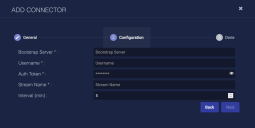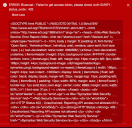Configuring Oracle Cloud Infrastructure (OCI) Connectors
This connector allows Stellar Cyber to ingest logs from the Oracle Cloud Infrastructure (OCI) and add the records to the data lake.
Oracle Cloud Infrastructure integration with Stellar Cyber provides advanced threat detection and response capabilities, combining Oracle's security solutions with real-time threat intelligence and automated response workflows to improve incident response and threat mitigation.
This connector queries the Oracle Streaming Service to collect log data found within a provided stream name. The stream can be configured for different log types.
Stellar Cyber connectors with the Collect function (collectors) may skip collecting some data when the ingestion volume is large, which potentially can lead to data loss. This can happen when the processing capacity of the collector is exceeded.
Connector Overview: Oracle Cloud Infrastructure
Capabilities
-
Collect: Yes
-
Respond: No
-
Native Alerts Mapped: Yes

-
Runs on: DP
-
Interval: Configurable
Collected Data
|
Content Type |
Index |
Locating Records |
|---|---|---|
|
Log data in provided Stream Name |
Syslog |
Domain
N/A
Response Actions
N/A
Third Party Native Alert Integration Details
This connector ingests logs from OCI to get the raw alerts that are stored in the Syslog index.
Stellar Cyber maps OCI CloudGuard alerts. The alerts are read from the Syslog index, enriched with Stellar Cyber fields, and mapped (with de-duplication) to the Alerts index.
Deduplication is by tenantid, oracle.data.additionalDetails.tenantId, event.threat.name, and cloud.resource.id.
The resource types include instances, buckets, and others.
For details, see Integration of Third Party Native Alerts.
Required Credentials
-
Bootstrap Server, Username, Auth Token (Password), and Stream Name
Locating Records
To search the alerts in the Alerts index, use the query: msg_class: oracle_cloud_guard AND exists:event.threat.name
To search the Original Records in the Syslog index, use the query: msg_class: oracle_cloud_guard AND exists:event.threat.name
Let us know if you find the above overview useful.
Adding an Oracle Cloud Infrastructure Connector
To add an Oracle Cloud Infrastructure (OCI) connector:
- Obtain your Oracle Cloud Infrastructure credentials
- Add the connector in Stellar Cyber
- Test the connector
- Verify ingestion
Obtaining your OCI Credentials
Follow the guidance in the Oracle Cloud Infrastructure documentation for Creating Streams to create the credentials for Stellar Cyber API calls. You can also refer to Kafka Python Client and Streaming Quickstart.
-
Log in as an administrative user to the Oracle Cloud Console with your Oracle Cloud Infrastructure account.
-
Navigate to Analytics & AI and choose Streaming under Messaging.
- Navigate to Analytics and choose Stream Pools. Choose the Compartment in which the stream was configured. For Create Stream Pool, choose DefaultPool.
- Navigate to Kafka Connection Settings.
- In Bootstrap Servers, note the Bootstrap Server. It has the format:
cell-1.streaming.<region>.oci.oraclecloud.com:9092. - In SASL Connection Strings, note the Username. It has the format:
<OCI_tenancy_name>/<your_OCI_username>/<stream_pool_OCID>. - In SASL Connection Strings, note the Password. It has the format:
<your_OCI_user_auth_token>.
- In Bootstrap Servers, note the Bootstrap Server. It has the format:
-
Navigate to Analytics and choose Streams. Note the stream name.
Fetching Audit Logs
Once the stream is configured, you need to send audit logs to the configured stream.
Follow the guidance in the Oracle Cloud Infrastructure documentation for Creating a Connector with a Logging Source to transfer log data from the logging service to a target service.
Adding the Connector in Stellar Cyber
With the access information handy, you can add an OCI connector in Stellar Cyber:
-
Log in to Stellar Cyber.
-
Click System | Integration | Connectors. The Connector Overview appears.
-
Click Create. The General tab of the Add Connector screen appears. The information on this tab cannot be changed after you add the connector.
The asterisk (*) indicates a required field.
-
Choose PaaS from the Category drop-down.
-
Choose Oracle Cloud Infrastructure from the Type drop-down.
-
For this connector, the supported Function is Collect, which is enabled already.
-
Enter a Name.
This field does not accept multibyte characters.
-
Choose a Tenant Name. This identifies which tenant is allowed to use the connector.
-
Choose the device on which to run the connector.
-
(Optional) When the Function is Collect, you can create Log Filters. For information, see Managing Log Filters.

-
Click Next. The Configuration tab appears.
The asterisk (*) indicates a required field.
-
Enter the Bootstrap Server you noted above.
-
Enter the Username you noted above.
-
Enter the Auth Token (the Password) you noted above.
-
Enter the Stream Name you noted above.
-
Choose the Interval (min). This is how often the logs are collected.
-
Click Next. The final confirmation tab appears.
-
Click Submit.
To pull data, a connector must be added to a Data Analyzer profile if it is running on the Data Processor.
The new connector is immediately active.
Testing the Connector
When you add (or edit) a connector, we recommend that you run a test to validate the connectivity parameters you entered. (The test validates only the authentication / connectivity; it does not validate data flow).
For connectors running on a sensor, Stellar Cyber recommends that you allow 30-60 seconds for new or modified configuration details to be propagated to the sensor before performing a test.
-
Click System | Integrations | Connectors. The Connector Overview appears.
-
Locate the connector that you added, or modified, or that you want to test.
-
Click Test at the right side of that row. The test runs immediately.
Note that you may run only one test at a time.
Stellar Cyber conducts a basic connectivity test for the connector and reports a success or failure result. A successful test indicates that you entered all of the connector information correctly.
To aid troubleshooting your connector, the dialog remains open until you explicitly close it by using the X button. If the test fails, you can select the button from the same row to review and correct issues.
The connector status is updated every five (5) minutes. A successful test clears the connector status, but if issues persist, the status reverts to failed after a minute.
Repeat the test as needed.
Verifying Ingestion
To verify ingestion:
- Click Investigate | Threat Hunting. The Interflow Search tab appears.
- Change the Indices to Syslog. The table immediately updates to show ingested Interflow records.












